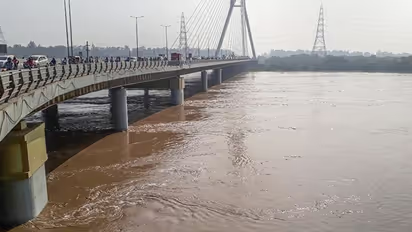Yamuna pollution: Delhi plans to treat all sewage generated in city by year-end

Synopsis
The main cause of high pollution levels in the river is untapped wastewater from unauthorised colonies, slum clusters, and poor-quality treated wastewater discharged from sewage treatment plants (STPs) and common effluent treatment plants (CETPs).
The Delhi government's environment department has informed Lieutenant Governor VK Saxena that the capital aims to treat all sewage generated in the city according to prescribed standards by December, which will help to reduce the pollution load in the Yamuna river.
During a meeting last week, officials informed the LG that the capital's sewage treatment plants (STPs) would be able to treat approximately 814 million gallons of wastewater per day (MGD) by December.
Saxena called the meeting to take stock of the situation before the first meeting of a new high-level committee appointed by the National Green Tribunal to clean up the Yamuna. The green tribunal had asked Delhi's LG to head the committee.
The environment department, in its presentation, informed the Delhi LG that the capital produces 786 million gallons of sewage (MGD) per day. The capital's 35 STPs have a total treatment capacity of 632 MGD.
These STPs presently are utilising only 69 per cent of their installed capacity, just 530 MGD of the 768 MGD sewage being treated.
According to the official, only 160.5 MGD of the treated wastewater meets the prescribed standards, which require BOD (biological oxygen demand) and TSS (total soluble solids) to be less than 10 milligrammes per litre.
The amount of oxygen aerobic microorganisms require to decompose organic material in a water body, which is an important parameter for assessing water quality, is defined as BOD. BOD levels of less than 3 milligrammes per litre are considered acceptable.
The officials said Delhi's sewage treatment capacity would rise to 727 MGD by June and 814 MGD by December of this year. The treatment capacity will be increased to 935 MGD by June 2024 to accommodate future increases in sewage generation.
Additionally, the official said upgrading 18 existing STPs would increase cumulative treatment capacity by 93.2 MGD, and rehabilitating three existing STPs will add another 70 MGD.
The construction of three STPs in Okhla, Delhi Gate, and Sonia Vihar will increase treatment capacity by 47 MGD, while 40 decentralised sewage treatment plants will be able to treat an additional 92 MGD.
Therefore, the installed treatment capacity will increase from 632 MGD to 934.5 MGD by June 2024, the official continued.
The 22-kilometre stretch of the river between Wazirabad and Okhla in Delhi, which accounts for less than 2 per cent of the river's length, accounts for roughly 80 per cent of its pollution load.
The main cause of high pollution levels in the river is untapped wastewater from unauthorised colonies, slum clusters, and poor-quality treated wastewater discharged from sewage treatment plants (STPs) and common effluent treatment plants (CETPs).
The Delhi government has said that the Yamuna will be cleaned to bathing standards by February 2025. If the BOD is less than three milligrammes per litre and the dissolved oxygen (DO) is greater than five milligrammes per litre, the river is suitable for bathing.
(With inputs from PTI)
Also Read: Dense fog creates low visibility in Delhi-NCR, 6 trains, several flights delayed
Also Read: Boat tragedy in Yamuna; 3 dead, several missing in UP's Banda
Also Read: Toxic Yamuna: Sprinkling water in river to remove foam? Delhi govt mocked for 'gimmick'
Stay updated with the Breaking News Today and Latest News from across India and around the world. Get real-time updates, in-depth analysis, and comprehensive coverage of India News, World News, Indian Defence News, Kerala News, and Karnataka News. From politics to current affairs, follow every major story as it unfolds. Get real-time updates from IMD on major cities weather forecasts, including Rain alerts, Cyclone warnings, and temperature trends. Download the Asianet News Official App from the Android Play Store and iPhone App Store for accurate and timely news updates anytime, anywhere.